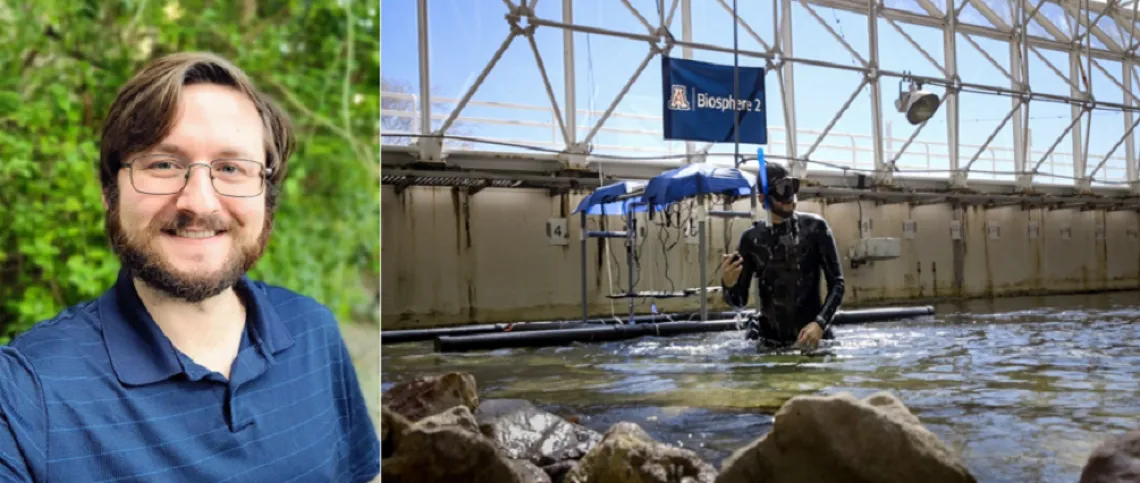Meet Dr. Killam!

Giant clams not only serve as impressive physical specimens with shells spanning more than four feet across and lifespans of more than 100 years, they also hold an important ecological niche in supporting coral reefs. And, as Dr. Killam aims to show, giant clams can provide insight into both current and prehistoric ocean conditions. With the support of the UArizona Postdoctoral Research Development Grant (PRDG), Dr. Killam is expanding our understanding of historic changes in our ocean through advanced analysis of the giant clam shell and how these animals may respond to current climate changes and ocean acidification.
Beginning in 2020, Dr. Daniel Killam has been studying giant clams (Tridacna spp.) as a postdoctoral fellow in the Department of Geosciences at the Biosphere 2. At the onset of his work, Dr. Killam made breakthroughs in giant clam research by successfully cultivating specimens in the 700,000 gallon ocean tank maintained at the Biosphere 2.
“We didn’t know entering my project whether the clams would be able to live; it was a big risk, but it worked out, so the gamble paid off”.
As the first research team successful in growing giant clams in captivity at Biosphere 2, they were able to carefully modify the conditions of the replicate ocean while making frequent and precise measurements of how the animals respond to these changes.
Using his 2021 PRDG funding, Dr. Killam collected preliminary data on the growth of the clams in the realistic Biosphere 2 environment, where pH levels vary throughout the day at the same frequency and amplitude as is seen on real coral reefs. In collaboration with Dr. Gavin Foster at University of Southampton, Dr. Killam was able to measure boron isotopes (boron atoms with varying levels of neutrons) contained within the giant clam shells, which are directly linked to the pH of the water the animal lived in. “The initial data is suggesting that we can actually observe those little wiggles [of pH] on a daily basis on these clam shells, because they grow so quickly,” Killam explains.
Dr. Killam’s research on giant clam development will inform predictions of how climate change and ocean acidification will impact the health of this animal that plays a vital role in maintaining coral reef health. “There are needs for better records of [ocean] pH in the past, before humans were present, during times of natural, ancient, climate change when extinctions occurred,” Killam added. The shell pH recordings done at the Foster Lab will serve as a model to compare against measurements of giant clam fossils to determine the pH in the oceans where these ancient clams lived. This record of ocean acidification through history will shed light on how current trends in ocean acidification differ due to human impact.
Research that started with a boost from a PRDG is already getting attention from other funding sources. Killam shared: “We found additional funding to expand [the project] very ambitiously, from the Royal Society, which funds visiting researchers to the UK. It’s basically become another pillar of my postdoc that I didn’t anticipate being able to do. [The PRDG] really provided a useful means to expand the postdoc beyond what initially had been envisioned.” Dr. Killam anticipates the project he initiated will continue long after his time at the Biosphere 2 comes to an end.
“We have three clams in the water still that are continuing to grow,” he said. “From a personal standpoint, I hope to continue visiting them over the next several decades as they live and prosper.”
Check out more of Dr. Killam's exciting research in this article by Research, Innovation, and Impact!
